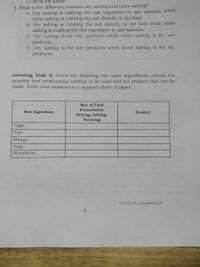
Human Anatomy & Physiology (11th Edition)
11th Edition
ISBN: 9780134580999
Author: Elaine N. Marieb, Katja N. Hoehn
Publisher: PEARSON
expand_more
expand_more
format_list_bulleted
Question
Given the following raw main ingredients choose rhe possible food preservation method to be used and the product that can be made

Transcribed Image Text:D. All of the above.
5. What is the difference between dry salting and brine salting?
A. Dry saiting is soaking the raw ingredient in salt solution while
brine salting is rubbing the salt directly in the food.
B. Dry salting is rubbing the salt directly in the food while brine
salting is soaking the raw ingredient in salt solution.
C. Dry salting is for dry products while brine salting is for wet
products.
D. Dry salting is for wet products while brine salting is for dry
products.
Learning Task 2: Given the following raw main ingredients, choose the
possible food preservation method to be used and the product that can be
made. Write your answers on a separate sheet of paper.
Way of Food
Preservation
Raw Ingredient
Product
(Drying, Salting,
Freezing)
Eggs
Fish
Mango
Pork
Strawberry
PIVOT 4A CALABARZON
Expert Solution
This question has been solved!
Explore an expertly crafted, step-by-step solution for a thorough understanding of key concepts.
This is a popular solution
Trending nowThis is a popular solution!
Step by stepSolved in 2 steps

Knowledge Booster
Learn more about
Need a deep-dive on the concept behind this application? Look no further. Learn more about this topic, biology and related others by exploring similar questions and additional content below.Similar questions
- Milk is usually pasteurized by a. the high-temperature short-time method c. batch method b. ultrapasteurization d. electrical currentsarrow_forwardColumbia CNA with 5% Sheep Blood Agar is undefined, differential and selective. Which ingredient contributes to making it BOTH undefined and differential? 10000 Sheep's Blood Pancreatic digest of casein Yeast extract Corn Starch Colistinarrow_forwardMcConkey agar plate is used to determine which carbohydrates a bacteria can ferment if the bacteria can produce gelatinase if the organism can produce catalase which antibiotics a bacteria is susceptible to the type of hemolysis a bacteria is capable of producingarrow_forward
- Make an accurate colored of what you observed on the mannitol salt agar plate.arrow_forward1. Name of the product 2. Predominant ingredient by weight 3. Serving size 4. How many total number of servings are there in one container 5. What is the fortification or enrichment status of the product 6. What is in one serving in terms of following criteria that is a) Is it high in particular nutrients if so which ones b) reliable source of any nutrients? If so, which ones? c) Reduced in calories or any nutrients? If so which ones? 7. Is your chosen product free of fat, sodium or sugar or other food nutrients If so, describe below: FREE OF LOW IN VERY LOW IN Attach the picture of label to the worksheet and upload Nutrition Classarrow_forwardIf there is growth and a color change in the Mannitol Salt Plate, which microorganism is it most likely to be? Staphrlococcus aureus O Streptococcus faecalis O Staphylococcus epidermidis Streptococcus agalactiaearrow_forward
- Is starch hydrolysis lab test a efficient test for a unkown intestinal bacteria.arrow_forwardO The following is a Mannitol Salt Agar plate. What does the growth on this plate indicate? www TAN ASM's MicrobeLibrary Reynolds lactose metabolism tolerance of the dyes and chemicals in the agar tolerance of the salt mannitol metabolismarrow_forwardWhich of the following test will be useful for initial distinction between Which of the following test will be useful for initial distinction bet Salmonella and Escherichia? Lactose fermentation in MacConkey Motility H2S production in Indole medium Glucose fermentation in KIAarrow_forward
arrow_back_ios
SEE MORE QUESTIONS
arrow_forward_ios
Recommended textbooks for you
 Human Anatomy & Physiology (11th Edition)BiologyISBN:9780134580999Author:Elaine N. Marieb, Katja N. HoehnPublisher:PEARSON
Human Anatomy & Physiology (11th Edition)BiologyISBN:9780134580999Author:Elaine N. Marieb, Katja N. HoehnPublisher:PEARSON Biology 2eBiologyISBN:9781947172517Author:Matthew Douglas, Jung Choi, Mary Ann ClarkPublisher:OpenStax
Biology 2eBiologyISBN:9781947172517Author:Matthew Douglas, Jung Choi, Mary Ann ClarkPublisher:OpenStax Anatomy & PhysiologyBiologyISBN:9781259398629Author:McKinley, Michael P., O'loughlin, Valerie Dean, Bidle, Theresa StouterPublisher:Mcgraw Hill Education,
Anatomy & PhysiologyBiologyISBN:9781259398629Author:McKinley, Michael P., O'loughlin, Valerie Dean, Bidle, Theresa StouterPublisher:Mcgraw Hill Education, Molecular Biology of the Cell (Sixth Edition)BiologyISBN:9780815344322Author:Bruce Alberts, Alexander D. Johnson, Julian Lewis, David Morgan, Martin Raff, Keith Roberts, Peter WalterPublisher:W. W. Norton & Company
Molecular Biology of the Cell (Sixth Edition)BiologyISBN:9780815344322Author:Bruce Alberts, Alexander D. Johnson, Julian Lewis, David Morgan, Martin Raff, Keith Roberts, Peter WalterPublisher:W. W. Norton & Company Laboratory Manual For Human Anatomy & PhysiologyBiologyISBN:9781260159363Author:Martin, Terry R., Prentice-craver, CynthiaPublisher:McGraw-Hill Publishing Co.
Laboratory Manual For Human Anatomy & PhysiologyBiologyISBN:9781260159363Author:Martin, Terry R., Prentice-craver, CynthiaPublisher:McGraw-Hill Publishing Co. Inquiry Into Life (16th Edition)BiologyISBN:9781260231700Author:Sylvia S. Mader, Michael WindelspechtPublisher:McGraw Hill Education
Inquiry Into Life (16th Edition)BiologyISBN:9781260231700Author:Sylvia S. Mader, Michael WindelspechtPublisher:McGraw Hill Education

Human Anatomy & Physiology (11th Edition)
Biology
ISBN:9780134580999
Author:Elaine N. Marieb, Katja N. Hoehn
Publisher:PEARSON

Biology 2e
Biology
ISBN:9781947172517
Author:Matthew Douglas, Jung Choi, Mary Ann Clark
Publisher:OpenStax

Anatomy & Physiology
Biology
ISBN:9781259398629
Author:McKinley, Michael P., O'loughlin, Valerie Dean, Bidle, Theresa Stouter
Publisher:Mcgraw Hill Education,

Molecular Biology of the Cell (Sixth Edition)
Biology
ISBN:9780815344322
Author:Bruce Alberts, Alexander D. Johnson, Julian Lewis, David Morgan, Martin Raff, Keith Roberts, Peter Walter
Publisher:W. W. Norton & Company

Laboratory Manual For Human Anatomy & Physiology
Biology
ISBN:9781260159363
Author:Martin, Terry R., Prentice-craver, Cynthia
Publisher:McGraw-Hill Publishing Co.

Inquiry Into Life (16th Edition)
Biology
ISBN:9781260231700
Author:Sylvia S. Mader, Michael Windelspecht
Publisher:McGraw Hill Education